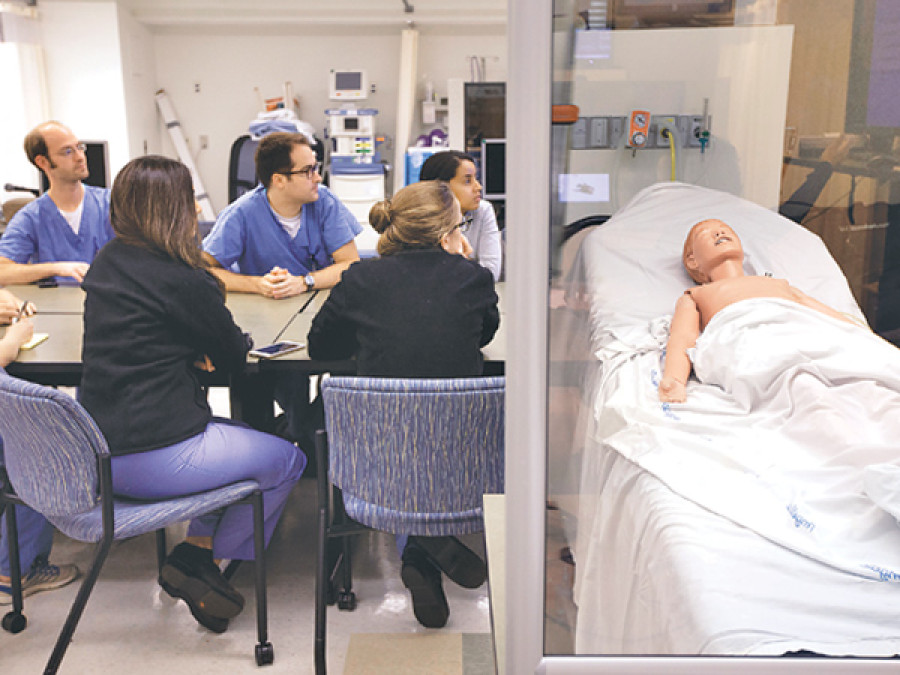Health
Artificial Patients, Real Learning
Although simulator participants know they are working on plastic dummies overseen by teachers, they often lose themselves in the moment
The New York Times
The patient’s blood pressure had reportedly crashed in the ambulance; a gunshot wound had damaged the heart. In the operating room, a medical resident, Dr Dan Hashimoto, slid a knife into the patient’s chest and sliced horizontally, from the sternum across the torso.
He thrust his hand into the gash, grasped the beating heart and squeezed, to the tempo of 100 beats a minute. Noticing bleeding from the right ventricle, Dr Hashimoto stopped pumping to sew up the hole. The pulse recovered, and blood pressure climbed.
Concerned there might be more bleeding in the belly, Dr Hashimoto moved to stop blood flow to the aorta. He struggled a bit to position the clamp. “Remember your anatomy,” the attending physician, Dr Marc de Moya, advised over Dr Hashimoto’s shoulder.
Moments later, Dr De Moya pronounced the procedure a success.
Yet no one’s life had been saved. Dr Hashimoto, a third-year-resident at Massachusetts General Hospital, had been practicing what is known as an emergency department thoracotomy on a rubber and plastic dummy that—but for the fact that it did not have a head—felt and acted remarkably like a human body.
Simulations have been part of medical training for centuries. But technological advances in computing, materials and production, including 3-D printing, are driving so-called trainers to a level of realism previously unimaginable.
On Monday, at its annual Global Pediatric Innovation Summit, Boston Children’s Hospital unveiled two new simulators. One had the real feel of a newborn’s skin, muscle and pulsing veins that will be used to simulate a heart-lung bypass; the other allows doctors to practice adding a drain to a brain overwhelmed with fluid. Underneath the mannequins’ silicone-covered torsos and necks are hand-sculpted and moulded muscles and blood vessels filled with mock blood—the right thickness to feel realistic.
The Children’s Hospital simulators and the dummy simulating the thoracotomy at Massachusetts General Hospital were created by people with an expertise in movie special effects. Fractured FX, which won an Emmy for its special effects in the show “American Horror Story,” designed the mannequins for Children’s. The Massachusetts General Hospital mannequin was made by the founders of The Chamberlain Group in Great Barrington, Massachusetts, who worked on special effects in movies like The Matrix.
The materials are the same used on movie sets and to make prosthetics look real, said Justin Raleigh, the chief executive of Fractured FX, but he added that the company’s standards of realism were far higher on the simulators than in Hollywood. He shared magnetic resonance imaging tests, CT scans and hours of conversation with Boston Children’s engineers and doctors to get the anatomical details right, down to the fibrous membrane between the muscle and veins.
Such cutting-edge realism enables medical teams to better learn, said Dr Peter Weinstock, who directs the expansive SIMPeds programme at Boston Children’s. At Mass General, simulation has become a regular part of the practice of medicine, to train students and to keep the skills of its 10,000 clinical employees up-to-date, said Dr James Gordon, the director of the hospital’s MGH Learning Laboratory. Ten departments across the hospital now have simulation setups—including a mannequin stashed behind a curtain in a patient room in the ER—so busy hospital staff can easily slip training into their day.
Leading the simulation gave Dr Hashimoto, the Massachusetts General Hospital resident, the chance to feel what it was like to hold a beating heart in his hand, to search through a blood-soaked chest cavity for the source of leaks, and to practice the physical manoeuvres needed to hopefully save someone’s life himself. “Now, I can say I know exactly how this is supposed to go,” he said after the simulated procedure. “Now I can be more helpful rather than being worried about being in the way.”
Although simulator participants know they are working on plastic dummies overseen by teachers, they often lose themselves in the moment. The bleating monitors, open wound and pressure to diagnose or treat correctly make it feel like the real thing. “Once I opened the chest and saw the pericardium and saw blood around there, that’s when everything else got forgotten,” Dr Hashimoto said, referring to the sac around the heart. Both Boston Children’s and Mass General, which funded its thoracotomy simulator with a grant from the Department of Defense, plan to sell their simulators and educational training programmes to other teaching hospitals across the world.
Mannequins are not the only type of realistic simulators. Dassault Systèmes in Waltham, Massach-usetts, has created a virtual 3-D heart model, to be used by device makers developing products as well as doctors planning operations. It can be controlled with a joystick and projected onto walls to transport viewers through an anatomically correct beating heart.
Steve Levine, director of the company’s Living Heart Project, is pushing to make the simulation more personalised. Instead of showing a generic heart, Dr Levine is developing a visual library of different heart conditions; eventually he hopes to offer surgeons a simulation using their patient’s own anatomy.
Children’s Hospital’s simulators will soon have a plug-and-play component, Dr Weinstock said, where a surgeon preparing to operate, say, on a brain tumour will be able to 3-D print the child’s cancer from a CT scan, and then insert it into the trainer for a run-through. Dr Gordon of Massachusetts General Hospital said his vision for the future of simulation came from Star Trek’s holodeck. He wants to see a trainee walk into an empty room, push a button and be immersed in a virtual version of surgery, while feeling the sensation of cutting through real flesh. “People are beginning to build the building blocks of what this might look like,” he said. —©2015 The New York Times
By Karen Weintraub




 15.12°C Kathmandu
15.12°C Kathmandu












%20(1).jpg&w=300&height=200)
